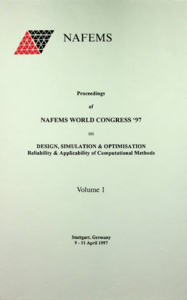
This paper on "Adaptivity of Stiffness and Damping Parameters in a Finite Element Model Through Comparison with Measured Dynamic Results" was presented at the NAFEMS World Congress on Design, Simulation & Optimisation: Reliability & Applicability of Computational Methods - 9-11 April 1997, Stuttgart, Germany.
Summary
Modal analysis is widely used for determining the dynamical behaviour of machine tools. Simulation and analysis of dynamic response of coupled systems with finite element method is very uncertain because of the difficulty in describing the dynamic effects of the coupling elements between the main components exactly. In order to obtain a better simulation model, static and dynamic structural properties are adapted to the measured behaviour by minimisation of a function describing the errors of the finite element solution compared to the measured data. Within the finite element model coupling elements are simulated by springs and dampers with variable defined stiffness and damping coefficients. The values of these coefficients are calculated by an optimisation algorithm, i.e. the coefficients are the design variables of the optimisation model. The objective function is a weighted sum of the differences of measured and calculated eigenfrequencies, eigenshapes and amplitudes at resonance frequencies, i.e. a modified correlation factor.



